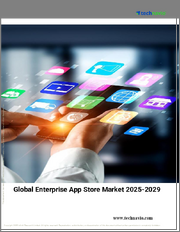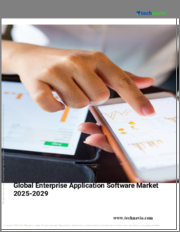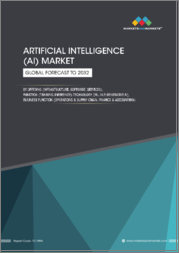
|
시장보고서
상품코드
1560945
기업 애플리케이션 시장 보고서 : 솔루션, 조직 규모, 도입 형태, 최종사용자, 지역별(2024-2032년)Enterprise Application Market Report by Solution, Organization Size, Deployment Mode, End User, and Region 2024-2032 |
||||||
세계의 기업 애플리케이션 시장 규모는 2023년에 2,947억 달러에 달했습니다. 향후 IMARC Group은 2024-2032년 성장률(CAGR)은 6.8%를 보이며, 2032년에는 5,510억 달러에 달할 것으로 예측하고 있습니다.
기업 애플리케이션에는 디지털 컨텐츠 제작, 커뮤니케이션 및 협업 소프트웨어, 고객 관계 관리(CRM), 전사적 자원 관리(ERP) 등이 포함됩니다. 이러한 용도는 확장 가능하고, 컴포넌트 기반이며, 데이터 중심적이고, 사용자 친화적입니다. 영업, 재무, 회계, 재고, 인사, 제조 등 핵심 비즈니스 프로세스를 단일 서버 아키텍처에서 실시간으로 통합하는 데 사용됩니다. 오피스 스위트, 프로젝트 포트폴리오 관리, 공급망 관리(SCM)의 이점을 제공합니다. 그 결과, 기업 네트워크에 도입되어 대량의 복잡한 데이터를 처리하는 비즈니스 프로세스를 자동화하고 전 세계 공급업체, 무역회사, 고객과 기업을 연결하는 데 활용되고 있습니다.
기업 애플리케이션 시장 동향 :
비즈니스가 전 세계에서 확대됨에 따라 기업은 대량의 데이터 관리라는 문제에 직면해 있습니다. 이는 전 세계에서 기업 애플리케이션의 보급을 촉진하는 중요한 요인 중 하나입니다. 기업 애플리케이션은 스마트한 비즈니스를 구축하기 위해 협업 강화, 효율성 향상, 위험 감소, 데이터 연계, 실시간 인사이트을 제공합니다. 또한 은행, 금융 서비스 및 보험(BFSI) 부문은 균형 잡힌 재무 구조를 구축하고 유능한 인재를 고용하기 위해 채택하고 있습니다. 이와는 별도로 인공지능(AI), 사물인터넷(IoT), 엣지 컴퓨팅과 같은 기술의 통합은 중요한 의사결정을 내리고, 혁신을 위한 투자를 최적화하며, 본질적인 고객 경험을 제공할 수 있는 민첩성을 제공합니다. 이는 다양한 최종 사용 산업에서 기업 애플리케이션의 활용을 더욱 확대시키고 있습니다. 또한 빠른 혁신과 지속성에 대한 관심이 높아지면서 기업은 하이브리드 클라우드 솔루션 전반에 걸쳐 ERP 소프트웨어를 배포하고 관리하고 있으며, 이는 전 세계에서 기업 애플리케이션에 대한 수요를 촉진하고 있습니다. 또한 여러 벤더들이 기업 애플리케이션의 다양한 기능을 업그레이드할 수 있는 커스터마이징 옵션을 제공하고 있으며, 이는 시장 성장을 가속할 것으로 예상됩니다.
이 보고서에서 다룬 주요 질문
- 세계 기업 애플리케이션 시장은 지금까지 어떻게 성장해왔고, 앞으로 어떻게 변화할 것인가?
- COVID-19는 세계 기업 애플리케이션 시장에 어떤 영향을 미쳤는가?
- 주요 지역 시장은?
- 솔루션별 시장 현황은?
- 조직 규모별 시장 현황은?
- 도입 형태별 시장 현황은?
- 최종사용자별 시장 분석은?
- 산업 밸류체인의 다양한 단계는?
- 업계의 주요 촉진요인과 과제는?
- 세계 기업 애플리케이션 시장의 구조와 주요 기업은?
- 업계의 경쟁은 어느 정도인가?
목차
제1장 서문
제2장 조사 범위와 조사 방법
- 조사의 목적
- 이해관계자
- 데이터 소스
- 1차 정보
- 2차 정보
- 시장 추정
- 보텀업 어프로치
- 톱다운 어프로치
- 조사 방법
제3장 개요
제4장 서론
- 개요
- 주요 업계 동향
제5장 세계의 기업 애플리케이션 시장
- 시장 개요
- 시장 실적
- COVID-19의 영향
- 시장 예측
제6장 시장 내역 : 솔루션
- 고객관계관리
- 시장 동향
- 시장 예측
- 전사적 자원 플래닝
- 시장 동향
- 시장 예측
- 공급망 관리
- 시장 동향
- 시장 예측
- 분석과 비즈니스 인텔리전스
- 시장 동향
- 시장 예측
- 인재 관리
- 시장 동향
- 시장 예측
- 생산성 툴
- 시장 동향
- 시장 예측
- 기타
- 시장 동향
- 시장 예측
제7장 시장 내역 : 조직 규모별
- 중소기업
- 시장 동향
- 시장 예측
- 대기업
- 시장 동향
- 시장 예측
제8장 시장 내역 : 도입 모드별
- 온프레미스
- 시장 동향
- 시장 예측
- 클라우드 기반
- 시장 동향
- 시장 예측
제9장 시장 내역 : 최종사용자별
- BFSI
- 시장 동향
- 시장 예측
- 제조업과 소매업
- 시장 동향
- 시장 예측
- 헬스케어와 의약품
- 시장 동향
- 시장 예측
- IT·통신
- 시장 동향
- 시장 예측
- 정부
- 시장 동향
- 시장 예측
- 기타
- 시장 동향
- 시장 예측
제10장 시장 내역 : 지역별
- 북미
- 미국
- 캐나다
- 아시아태평양
- 중국
- 일본
- 인도
- 한국
- 호주
- 인도네시아
- 기타
- 유럽
- 독일
- 프랑스
- 영국
- 이탈리아
- 스페인
- 러시아
- 기타
- 라틴아메리카
- 브라질
- 멕시코
- 기타
- 중동 및 아프리카
- 시장 동향
- 시장 내역 : 국가별
- 시장 예측
제11장 SWOT 분석
- 개요
- 강점
- 약점
- 기회
- 위협
제12장 밸류체인 분석
제13장 Porter's Five Forces 분석
- 개요
- 바이어의 교섭력
- 공급 기업의 교섭력
- 경쟁의 정도
- 신규 진출업체의 위협
- 대체품의 위협
제14장 가격 분석
제15장 경쟁 구도
- 시장 구조
- 주요 기업
- 주요 기업의 개요
- Accenture plc
- Fujitsu Limited
- Infosys Limited
- International Business Machines Corporation
- iTransition Group
- Microsoft Corporation
- Oracle Corporation
- Pegasystems Inc.
- Salesforce.com Inc.
- SAP SE
- Software AG
- Tata Consultancy Services Limited
The global enterprise application market size reached US$ 294.7 Billion in 2023. Looking forward, IMARC Group expects the market to reach US$ 551.0 Billion by 2032, exhibiting a growth rate (CAGR) of 6.8% during 2024-2032.
Enterprise applications include digital and content creation, communication and collaboration software, customer relationship management (CRM), and enterprise resource planning (ERP). They are scalable, component-based, data-centric, and user-friendly. They are used to integrate core business processes, such as sales, finance, accounting, inventory, human resources, and manufacturing, on a single server architecture in real-time. They provide the advantages of office suites, project and portfolio management, and supply chain management (SCM). Consequently, they are deployed in corporate networks to automate business processes with large amounts of complex data and connect enterprises with suppliers, commercial entities, and customers across the globe.
Enterprise Application Market Trends:
Due to the expansion of business globally, enterprises are facing challenges in managing large amounts of data. This represents one of the key factors driving the adoption of enterprise applications worldwide as they provide enhanced collaboration, improved efficiency, reduced risk, connected data, and real-time insights to build a smart business. Moreover, they are employed in the banking, financial services, and insurance (BFSI) sector to make a balanced financial structure and hire qualified talent. Apart from this, the integration of technologies like artificial intelligence (AI), the internet of things (IoT), and edge computing are providing agility to make critical decisions, optimize investments to fund innovation, and deliver essential customer experiences. This is further expanding the usage of enterprise applications in various end use industries. Furthermore, due to the growing focus on rapid innovation and continuation, organizations are deploying and managing ERP software across hybrid cloud solutions, which, in turn, is catalyzing the demand for enterprise applications around the world. Additionally, several vendors are providing customization options to upgrade various features of enterprise applications, which is anticipated to impel the growth of the market.
Key Market Segmentation:
IMARC Group provides an analysis of the key trends in each sub-segment of the global enterprise application market report, along with forecasts at the global, regional and country level from 2024-2032. Our report has categorized the market based on solution, organization size, deployment mode and end user.
Breakup by Solution:
- Customer Relationship Management
- Enterprise Resource Planning
- Supply Chain Management
- Analytics and Business Intelligence
- Human Capital Management
- Productivity Tools
- Others
Breakup by Organization Size:
- Small and Medium Enterprises
- Large Enterprises
Breakup by Deployment Mode:
- On-premises
- Cloud-based
Breakup by End User:
- BFSI
- Manufacturing and Retail
- Healthcare and Pharmaceuticals
- IT and Telecommunication
- Government
- Others
Breakup by Region:
- North America
- United States
- Canada
- Asia-Pacific
- China
- Japan
- India
- South Korea
- Australia
- Indonesia
- Others
- Europe
- Germany
- France
- United Kingdom
- Italy
- Spain
- Russia
- Others
- Latin America
- Brazil
- Mexico
- Others
- Middle East and Africa
Competitive Landscape:
The competitive landscape of the industry has also been examined along with the profiles of the key players being Accenture plc, Fujitsu Limited, Infosys Limited, International Business Machines Corporation, iTransition Group, Microsoft Corporation, Oracle Corporation, Pegasystems Inc., Salesforce.com Inc., SAP SE, Software AG and Tata Consultancy Services Limited.
Key Questions Answered in This Report:
- How has the global enterprise application market performed so far and how will it perform in the coming years?
- What has been the impact of COVID-19 on the global enterprise application market?
- What are the key regional markets?
- What is the breakup of the market based on the solution?
- What is the breakup of the market based on the organization size?
- What is the breakup of the market based on the deployment mode?
- What is the breakup of the market based on the end user?
- What are the various stages in the value chain of the industry?
- What are the key driving factors and challenges in the industry?
- What is the structure of the global enterprise application market and who are the key players?
- What is the degree of competition in the industry?
Table of Contents
1 Preface
2 Scope and Methodology
- 2.1 Objectives of the Study
- 2.2 Stakeholders
- 2.3 Data Sources
- 2.3.1 Primary Sources
- 2.3.2 Secondary Sources
- 2.4 Market Estimation
- 2.4.1 Bottom-Up Approach
- 2.4.2 Top-Down Approach
- 2.5 Forecasting Methodology
3 Executive Summary
4 Introduction
- 4.1 Overview
- 4.2 Key Industry Trends
5 Global Enterprise Application Market
- 5.1 Market Overview
- 5.2 Market Performance
- 5.3 Impact of COVID-19
- 5.4 Market Forecast
6 Market Breakup by Solution
- 6.1 Customer Relationship Management
- 6.1.1 Market Trends
- 6.1.2 Market Forecast
- 6.2 Enterprise Resource Planning
- 6.2.1 Market Trends
- 6.2.2 Market Forecast
- 6.3 Supply Chain Management
- 6.3.1 Market Trends
- 6.3.2 Market Forecast
- 6.4 Analytics and Business Intelligence
- 6.4.1 Market Trends
- 6.4.2 Market Forecast
- 6.5 Human Capital Management
- 6.5.1 Market Trends
- 6.5.2 Market Forecast
- 6.6 Productivity Tools
- 6.6.1 Market Trends
- 6.6.2 Market Forecast
- 6.7 Others
- 6.7.1 Market Trends
- 6.7.2 Market Forecast
7 Market Breakup by Organization Size
- 7.1 Small and Medium Enterprises
- 7.1.1 Market Trends
- 7.1.2 Market Forecast
- 7.2 Large Enterprises
- 7.2.1 Market Trends
- 7.2.2 Market Forecast
8 Market Breakup by Deployment Mode
- 8.1 On-premises
- 8.1.1 Market Trends
- 8.1.2 Market Forecast
- 8.2 Cloud-based
- 8.2.1 Market Trends
- 8.2.2 Market Forecast
9 Market Breakup by End User
- 9.1 BFSI
- 9.1.1 Market Trends
- 9.1.2 Market Forecast
- 9.2 Manufacturing and Retail
- 9.2.1 Market Trends
- 9.2.2 Market Forecast
- 9.3 Healthcare and Pharmaceuticals
- 9.3.1 Market Trends
- 9.3.2 Market Forecast
- 9.4 IT and Telecommunication
- 9.4.1 Market Trends
- 9.4.2 Market Forecast
- 9.5 Government
- 9.5.1 Market Trends
- 9.5.2 Market Forecast
- 9.6 Others
- 9.6.1 Market Trends
- 9.6.2 Market Forecast
10 Market Breakup by Region
- 10.1 North America
- 10.1.1 United States
- 10.1.1.1 Market Trends
- 10.1.1.2 Market Forecast
- 10.1.2 Canada
- 10.1.2.1 Market Trends
- 10.1.2.2 Market Forecast
- 10.1.1 United States
- 10.2 Asia-Pacific
- 10.2.1 China
- 10.2.1.1 Market Trends
- 10.2.1.2 Market Forecast
- 10.2.2 Japan
- 10.2.2.1 Market Trends
- 10.2.2.2 Market Forecast
- 10.2.3 India
- 10.2.3.1 Market Trends
- 10.2.3.2 Market Forecast
- 10.2.4 South Korea
- 10.2.4.1 Market Trends
- 10.2.4.2 Market Forecast
- 10.2.5 Australia
- 10.2.5.1 Market Trends
- 10.2.5.2 Market Forecast
- 10.2.6 Indonesia
- 10.2.6.1 Market Trends
- 10.2.6.2 Market Forecast
- 10.2.7 Others
- 10.2.7.1 Market Trends
- 10.2.7.2 Market Forecast
- 10.2.1 China
- 10.3 Europe
- 10.3.1 Germany
- 10.3.1.1 Market Trends
- 10.3.1.2 Market Forecast
- 10.3.2 France
- 10.3.2.1 Market Trends
- 10.3.2.2 Market Forecast
- 10.3.3 United Kingdom
- 10.3.3.1 Market Trends
- 10.3.3.2 Market Forecast
- 10.3.4 Italy
- 10.3.4.1 Market Trends
- 10.3.4.2 Market Forecast
- 10.3.5 Spain
- 10.3.5.1 Market Trends
- 10.3.5.2 Market Forecast
- 10.3.6 Russia
- 10.3.6.1 Market Trends
- 10.3.6.2 Market Forecast
- 10.3.7 Others
- 10.3.7.1 Market Trends
- 10.3.7.2 Market Forecast
- 10.3.1 Germany
- 10.4 Latin America
- 10.4.1 Brazil
- 10.4.1.1 Market Trends
- 10.4.1.2 Market Forecast
- 10.4.2 Mexico
- 10.4.2.1 Market Trends
- 10.4.2.2 Market Forecast
- 10.4.3 Others
- 10.4.3.1 Market Trends
- 10.4.3.2 Market Forecast
- 10.4.1 Brazil
- 10.5 Middle East and Africa
- 10.5.1 Market Trends
- 10.5.2 Market Breakup by Country
- 10.5.3 Market Forecast
11 SWOT Analysis
- 11.1 Overview
- 11.2 Strengths
- 11.3 Weaknesses
- 11.4 Opportunities
- 11.5 Threats
12 Value Chain Analysis
13 Porters Five Forces Analysis
- 13.1 Overview
- 13.2 Bargaining Power of Buyers
- 13.3 Bargaining Power of Suppliers
- 13.4 Degree of Competition
- 13.5 Threat of New Entrants
- 13.6 Threat of Substitutes
14 Price Analysis
15 Competitive Landscape
- 15.1 Market Structure
- 15.2 Key Players
- 15.3 Profiles of Key Players
- 15.3.1 Accenture plc
- 15.3.1.1 Company Overview
- 15.3.1.2 Product Portfolio
- 15.3.1.3 Financials
- 15.3.1.4 SWOT Analysis
- 15.3.2 Fujitsu Limited
- 15.3.2.1 Company Overview
- 15.3.2.2 Product Portfolio
- 15.3.2.3 Financials
- 15.3.2.4 SWOT Analysis
- 15.3.3 Infosys Limited
- 15.3.3.1 Company Overview
- 15.3.3.2 Product Portfolio
- 15.3.3.3 Financials
- 15.3.3.4 SWOT Analysis
- 15.3.4 International Business Machines Corporation
- 15.3.4.1 Company Overview
- 15.3.4.2 Product Portfolio
- 15.3.4.3 Financials
- 15.3.4.4 SWOT Analysis
- 15.3.5 iTransition Group
- 15.3.5.1 Company Overview
- 15.3.5.2 Product Portfolio
- 15.3.6 Microsoft Corporation
- 15.3.6.1 Company Overview
- 15.3.6.2 Product Portfolio
- 15.3.6.3 Financials
- 15.3.6.4 SWOT Analysis
- 15.3.7 Oracle Corporation
- 15.3.7.1 Company Overview
- 15.3.7.2 Product Portfolio
- 15.3.7.3 Financials
- 15.3.7.4 SWOT Analysis
- 15.3.8 Pegasystems Inc.
- 15.3.8.1 Company Overview
- 15.3.8.2 Product Portfolio
- 15.3.8.3 Financials
- 15.3.8.4 SWOT Analysis
- 15.3.9 Salesforce.com Inc.
- 15.3.9.1 Company Overview
- 15.3.9.2 Product Portfolio
- 15.3.9.3 Financials
- 15.3.9.4 SWOT Analysis
- 15.3.10 SAP SE
- 15.3.10.1 Company Overview
- 15.3.10.2 Product Portfolio
- 15.3.10.3 Financials
- 15.3.10.4 SWOT Analysis
- 15.3.11 Software AG
- 15.3.11.1 Company Overview
- 15.3.11.2 Product Portfolio
- 15.3.11.3 Financials
- 15.3.12 Tata Consultancy Services Limited
- 15.3.12.1 Company Overview
- 15.3.12.2 Product Portfolio
- 15.3.12.3 Financials
- 15.3.12.4 SWOT Analysis
- 15.3.1 Accenture plc



















